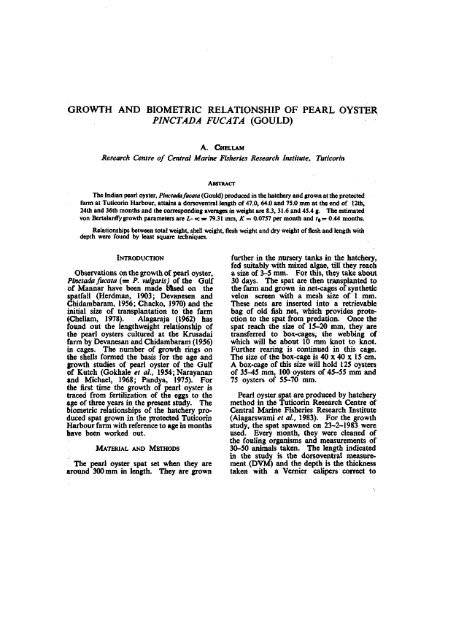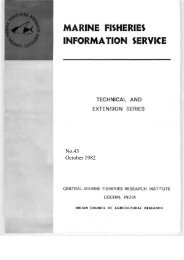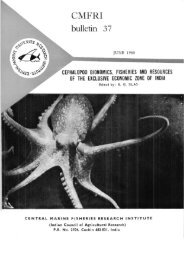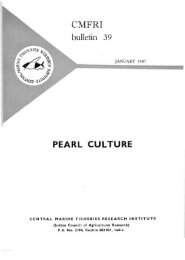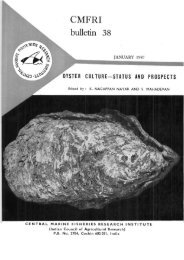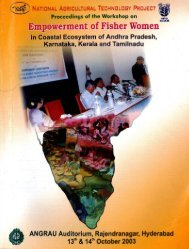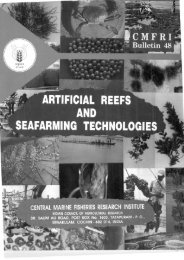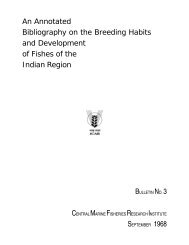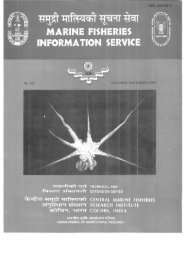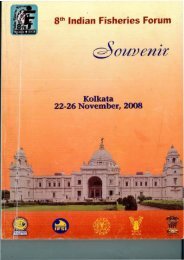growth and biometric relationship of pearl oyster ... - Eprints@CMFRI
growth and biometric relationship of pearl oyster ... - Eprints@CMFRI
growth and biometric relationship of pearl oyster ... - Eprints@CMFRI
Create successful ePaper yourself
Turn your PDF publications into a flip-book with our unique Google optimized e-Paper software.
GROWTH AND BIOMETRIC RELATIONSHIP OF PEARL OYSTER<br />
PINCTADA FUCATA (GOULD)<br />
A. CHELLAM<br />
Research Centre <strong>of</strong> Central Marine Fisheries Research Institute,<br />
Tuticorin<br />
ABSTRACT<br />
The Indian <strong>pearl</strong> <strong>oyster</strong>, Pinctadafucata (Gould) produced in the hatchery <strong>and</strong> grown at the protected<br />
farm at Tuticorin Harbour, attains a dorsoventral length <strong>of</strong> 47.0, 64.0 <strong>and</strong> 75.0 mm at the end <strong>of</strong> 12th,<br />
24tb <strong>and</strong> 36th months <strong>and</strong> the corresponding averages in weight are 8.3, 31.6 <strong>and</strong> 45.4 g. The estimated<br />
von Bertalanffy <strong>growth</strong> parameters are £- oc a: 79.31 ram, K = 0.0757 per month <strong>and</strong> t^ = 0.44 months.<br />
Relationships between total weight, shell weight, flesh weight <strong>and</strong> dry weight <strong>of</strong> flesh <strong>and</strong> length with<br />
depth were found by least square techniques.<br />
INTRODUCTION<br />
Observations on the <strong>growth</strong> <strong>of</strong> <strong>pearl</strong> <strong>oyster</strong>,<br />
Pinctadafucata (= P. vulgaris) <strong>of</strong> the Gulf<br />
<strong>of</strong> Mannar have been made b&sed on the<br />
spatfall (Herdman, 1903; Devanesen <strong>and</strong><br />
Chidambaram, 1956; Chacko, 1970) <strong>and</strong> the<br />
initial size <strong>of</strong> transplantation to the farm<br />
(Chellam, 1978). Alagaraja (1962) has<br />
found out the lengthweight <strong>relationship</strong> <strong>of</strong><br />
the <strong>pearl</strong> <strong>oyster</strong>s cultured at the Krusadai<br />
farm by Devanesan <strong>and</strong> Chidambaram (1956)<br />
in cages. The number <strong>of</strong> <strong>growth</strong> rings on<br />
the shells formed the basis for the age <strong>and</strong><br />
<strong>growth</strong> studies <strong>of</strong> <strong>pearl</strong> <strong>oyster</strong> <strong>of</strong> the Gulf<br />
<strong>of</strong> Kutch (Gokhale et al, 1954; Narayanan<br />
<strong>and</strong> Michael, 1968; P<strong>and</strong>ya, 1975). For<br />
the first time the <strong>growth</strong> <strong>of</strong> <strong>pearl</strong> <strong>oyster</strong> is<br />
traced from fertilization <strong>of</strong> the eggs to the<br />
age <strong>of</strong> three years in the present study. The<br />
<strong>biometric</strong> <strong>relationship</strong>s <strong>of</strong> the hatchery produced<br />
spat grown in the protected Tuticorin<br />
Harbour farm with reference to age in months<br />
have been worked out.<br />
MATERIAL AND METHODS<br />
The <strong>pearl</strong> <strong>oyster</strong> spat set when they are<br />
arotmd 300 mm in length. They are ^own<br />
further in the nursery tanks in the hatchery,<br />
fed suitably with mixed algae, till they reach<br />
a size <strong>of</strong> 3-5 mm. For this, they take about<br />
30 days. The spat are then transplanted to<br />
the farm <strong>and</strong> grown in net-cages <strong>of</strong> synthetic<br />
velon screen with a mesh size <strong>of</strong> 1 mm.<br />
These nets are inserted into a retrievable<br />
bag <strong>of</strong> old fish net, which provides protection<br />
to the spat from predation. Once the<br />
spat reach the size <strong>of</strong> 15-20 mm, they are<br />
transferred to box-cages, the webbing <strong>of</strong><br />
which will be about 10 mm knot to knot.<br />
Further rearing is continued in this cage.<br />
The size <strong>of</strong> the box-cage is 40 x 40 x 15 cm.<br />
A box-cage <strong>of</strong> this size will hold 125 <strong>oyster</strong>s<br />
<strong>of</strong> 35-45 mm, 100 <strong>oyster</strong>s <strong>of</strong> 45-55 mm <strong>and</strong><br />
75 <strong>oyster</strong>s <strong>of</strong> 55-70 mm.<br />
Pearl <strong>oyster</strong> spat are produced by hatchery<br />
method in the Tuticorin Research Centre <strong>of</strong><br />
Central Marine Fisheries Research Institute<br />
(Alagarswami et al, 1983). For the <strong>growth</strong><br />
study, the spat spawned on 23-2-1983 were<br />
used. Every month, they were cleaned <strong>of</strong><br />
the fouling organisms <strong>and</strong> measurements <strong>of</strong><br />
30-50 animals taken. The length indicated<br />
in the study is the dorsoventral measure^<br />
ment (DVM) <strong>and</strong> the depth is the thickness<br />
taken with a Vernier calipers correct to
A. CHELLAM<br />
0.1mm. The modal length <strong>and</strong> average depth<br />
for the <strong>oyster</strong>s in each month were calculated<br />
from the above data.<br />
Several batches <strong>of</strong> <strong>oyster</strong>s, spawned at<br />
different dates <strong>of</strong> the year were grown in the<br />
Tuticorin Harbour farm. For total weight,<br />
fljsh weight, shell weight <strong>and</strong> dry weight <strong>of</strong><br />
flesh, 30 animals <strong>of</strong> the known age ranging<br />
from 6 to 36 months were used. After<br />
weighing the <strong>oyster</strong>, the left shell was removed<br />
by cutting the adductor muscle <strong>of</strong> the<br />
left side along the shell with a scalpel. The<br />
fljsh, removed from the right shell <strong>and</strong><br />
after blotting the water from the flesh <strong>and</strong><br />
shell, was weighed separately with the help<br />
<strong>of</strong> a triple beam balance. The dry weight<br />
<strong>of</strong> flash was taken after drying in hot-air<br />
oven at 80°C for 24 hours.<br />
out regression analysis by least square<br />
method, the L«^ was found to be 79.31mm<br />
which is close to the maximum observed<br />
size (80.0 mm) in the course <strong>of</strong> mother <strong>oyster</strong><br />
culture in the Tuticorin farm. It is found<br />
that the points are well fitted by the straight<br />
line <strong>and</strong> the r» value is 0.999. The <strong>growth</strong><br />
parameter k is found to be 0.0757 per month.<br />
The value <strong>of</strong> to was found to be 0.44 month<br />
from age/length data. The <strong>growth</strong> curve<br />
<strong>of</strong> the <strong>pearl</strong> <strong>oyster</strong>s cultured at the farm at<br />
the Tuticorin Harbour, obtained by using<br />
the estimated parameters is presented in the<br />
Fig. 1. The <strong>growth</strong> curve fits well with the<br />
observed modal lengths <strong>of</strong> the <strong>growth</strong> period<br />
<strong>of</strong> 36 months.<br />
AGE AND GROWTH<br />
The monthly dominant modal length <strong>of</strong><br />
the samples observed during the 36 months<br />
period, was taken to describe the <strong>growth</strong><br />
pattern in the mathematical form using the<br />
von Bertalanfify's <strong>growth</strong> equation (Beverton<br />
<strong>and</strong> Holt, 1957).<br />
(0<br />
)0<br />
• Toll) wt.<br />
• StwII »t.<br />
• FItlli «l.<br />
20<br />
,..••"<br />
I ^»•<br />
« 1t 2< JO 3*<br />
Agt (menlhi)<br />
FIG. 2. Growth in total weight, shell weight <strong>and</strong><br />
flesh weight in the <strong>pearl</strong> <strong>oyster</strong>, P. fucata.<br />
MONTHS<br />
Fro. 1. The von Bertalanffy <strong>growth</strong> curve in length<br />
in the <strong>pearl</strong> <strong>oyster</strong>, Ptnctada fucata.<br />
The Loc, the asymptotic length <strong>and</strong> K, the<br />
<strong>growth</strong> parameter, were estimated from the<br />
Ford-Walford plot (Ford, 1933; Walford,<br />
1946) <strong>of</strong> Lt + 1 against Lt. By carrying<br />
In Fig. 2 the increase in total weight, shell<br />
weight <strong>and</strong> flesh weight are depicted for the<br />
corresponding age in months. In the 12th<br />
month, the <strong>pearl</strong> <strong>oyster</strong> attained an average<br />
weight <strong>of</strong> 8.3 g wherein shell weight was<br />
3.9 g <strong>and</strong> flesh weight 2.3 g only. But in<br />
the 24th month, it reached an average weight<br />
<strong>of</strong> 31.6 g which was nearly four times increase
BIOLOGY OF PEARL OYSTER<br />
in weight. The corresponding shell weight<br />
<strong>and</strong> flesh weight were 15.0 g <strong>and</strong> 8.1 g which<br />
were nearly 4 <strong>and</strong> 3.5 times higher respectively.<br />
At the end <strong>of</strong> the third year, the <strong>pearl</strong><br />
<strong>oyster</strong> attained an average weight <strong>of</strong> 45.4 g<br />
which was 1.4 times more than in the second<br />
year end. The shell weight increased to<br />
24.0 g which was 1.6 times more than in the<br />
end <strong>of</strong> the second year <strong>and</strong> the corresponding<br />
flesh weight was 11.8 g which was 1.4<br />
times more than in the end <strong>of</strong> second year.<br />
Fig. 2 shows that in the second year, rapid<br />
increase in body weight <strong>of</strong> <strong>pearl</strong> <strong>oyster</strong>s is<br />
taking place.<br />
groups indicating 36 months <strong>of</strong> <strong>growth</strong><br />
period. The scatter diagrams with the fitted<br />
lines shown in Fig. 3 indicate high correlation<br />
between the concerned variables.<br />
The equation derived are given below:<br />
Shell weight (Y) on Total weight (X)<br />
Y =-0.1397 -f- 0.5113 X<br />
Flesh weight (Y) on Total weight (X)<br />
Y = 0.0187 + 0.2611 X<br />
Dry weight <strong>of</strong> flesh (Y) on Total weight (X)<br />
Y = 0.0344 -h 0.0491 X<br />
Thus the <strong>pearl</strong> <strong>oyster</strong> contains an average<br />
<strong>of</strong> 51% shell weight, 26% flesh weight <strong>and</strong><br />
the dry weight <strong>of</strong> flesh is 5 % <strong>of</strong> its total<br />
weight.<br />
10 » 30<br />
Tool waigM (gm)<br />
Fio. 3. The <strong>relationship</strong>s between total weight -shell<br />
weight, total weight-flesh weight <strong>and</strong> total<br />
weight-diy flesh weight in the <strong>pearl</strong> <strong>oyster</strong>,<br />
P. fucata.<br />
BioMETRic RELATIONSHIPS<br />
Regression analyses were done to find out<br />
the <strong>relationship</strong> <strong>of</strong> the shell weight, flesh<br />
weight <strong>and</strong> dry flesh weight respectively<br />
with the total weight by tilie least square<br />
method using the mean weight <strong>and</strong> corresponding<br />
shell weight, flesh weight <strong>and</strong> dry<br />
weight <strong>of</strong> flesh <strong>of</strong> samples <strong>of</strong> difierent age<br />
«0<br />
FIO. 4. Length-depth <strong>relationship</strong> in the <strong>pearl</strong> <strong>oyster</strong>,<br />
P.fucata.<br />
The linear regression between the length<br />
<strong>and</strong> depth <strong>of</strong> the <strong>pearl</strong> <strong>oyster</strong> presented in<br />
Fig. 4 is found to be:<br />
Depth (Y) on Length (X)<br />
Y = -3.5747 + 0.4722 X.<br />
The depth <strong>of</strong> <strong>oyster</strong> increases at the rate<br />
<strong>of</strong> 0.47 time with that <strong>of</strong> dorsoventral measurement<br />
(DVM).<br />
The regression equation describing the<br />
length-total weight<strong>relationship</strong> is given below.<br />
Log Y = -3.3242 -f- 2.6043 Log X<br />
where X = dorsoventral measurement<br />
(length) in mm <strong>and</strong> Y = total weight in g.<br />
The depth-total weight <strong>relationship</strong> is described<br />
by the following equation:<br />
Log Y = -1.0427 + 1.6778 Log X<br />
where X = depth (thickness) in mm <strong>and</strong><br />
Y = total weight in g.
A. CHELLAM<br />
TABLE 1. Growth <strong>of</strong> <strong>pearl</strong> <strong>oyster</strong>, Pinctada fucata in the Tuticorin Harbour farm. Gulf <strong>of</strong> Mannar<br />
(April, 1983 to March, 1986;<br />
Date <strong>of</strong><br />
sampling<br />
1<br />
Age in<br />
months<br />
2<br />
No. <strong>of</strong><br />
<strong>oyster</strong>s<br />
3<br />
Range in<br />
length (DVM)<br />
(mm)<br />
4<br />
Modal<br />
length<br />
(mm)<br />
5<br />
Mean<br />
weight<br />
(g)<br />
6<br />
30- 4-83<br />
30- 5-83<br />
23- 6-83<br />
23- 7-83<br />
25- 8-83<br />
29- 9-83<br />
3-11-83<br />
8-12-83<br />
19- 1-84<br />
12- 2-84<br />
2- 4-84<br />
11- 5-84<br />
7- 6-84<br />
13- 7-84<br />
16- 8-84<br />
15- 9-84<br />
13-11-84<br />
14-12 84<br />
21- 1-85<br />
28- 2-85<br />
31- 3-85<br />
30- 4-85<br />
2&- 5-85<br />
29- 6-85<br />
16- 8-85<br />
20- 9-85<br />
30-10-85<br />
28-11-85<br />
4- 1-86<br />
30- 1-86<br />
25- 3-86<br />
1<br />
2<br />
3<br />
4<br />
5<br />
6<br />
g<br />
9<br />
10<br />
11<br />
12<br />
14<br />
15<br />
16<br />
17<br />
18<br />
20<br />
21<br />
22<br />
23<br />
24<br />
25<br />
26<br />
27<br />
29<br />
30<br />
31<br />
32<br />
33<br />
34<br />
36<br />
50<br />
50<br />
50<br />
50<br />
50<br />
30<br />
50<br />
50<br />
30<br />
50<br />
50<br />
30<br />
50<br />
50<br />
40<br />
40<br />
40<br />
40<br />
30<br />
30<br />
30<br />
32<br />
30<br />
30<br />
35<br />
28<br />
23<br />
23<br />
23<br />
23<br />
22<br />
3.0-11.2<br />
9.0-17.8<br />
12.0-24.0<br />
19.0-28.3<br />
22.0 35.2<br />
27.0-36.0<br />
31.7-47.0<br />
35.0^5.0<br />
41.5-52.8<br />
42.0-55.6<br />
43.2-56.0<br />
46.0-56.5<br />
47.0- 57.0<br />
44.0-58.0<br />
47.0-59.0<br />
48.0-59.0<br />
51.0-61.2<br />
49.0-62.0<br />
52.4-62.5<br />
54.0-65.5<br />
54.0-66.0<br />
54.0-66.5<br />
56.0-67.0<br />
56.0-67.5<br />
56.5-69.5<br />
56.2-70.5<br />
57.3-71.5<br />
59.0-72.0<br />
57.0-73.0<br />
61.0-74.0<br />
63.4-76.0<br />
4.5<br />
9.0<br />
15.0<br />
19.5<br />
25.0<br />
29.0<br />
36.0<br />
40.0<br />
42.5<br />
45.0<br />
47.0<br />
52.0<br />
53.5<br />
55.0<br />
56.0<br />
57.5<br />
59.5<br />
61.0<br />
62.0<br />
63.0<br />
64.0<br />
65.5<br />
66.5<br />
67.5<br />
69.5<br />
70.5<br />
71.0<br />
72.0<br />
73.0<br />
74.0<br />
75.0<br />
0.1<br />
0.2<br />
0.4<br />
0.5<br />
0.7<br />
1.5<br />
3.4<br />
4.4<br />
5.8<br />
7.0<br />
8.3<br />
11.6<br />
13.0<br />
14.4<br />
16.0<br />
18.0<br />
22.8<br />
25.0<br />
27.8<br />
29.6<br />
31.6<br />
33.0<br />
34.4<br />
36.2<br />
38.8<br />
40.0<br />
41.0<br />
42.0<br />
43.0<br />
43.8<br />
45.4<br />
DISCUSSION<br />
Devanesan <strong>and</strong> Chidambaram (1956)<br />
reared the <strong>pearl</strong> <strong>oyster</strong>s collected from the<br />
natural <strong>pearl</strong> <strong>oyster</strong> beds <strong>and</strong> from spatfall<br />
at Krusadai farm (Gulf <strong>of</strong> Mannar) <strong>and</strong><br />
found them to grow to a length <strong>of</strong> 45 mm,<br />
50 mm <strong>and</strong> 60 mm at the end <strong>of</strong> first, second<br />
<strong>and</strong> third years <strong>and</strong> 72 mm in six years.<br />
When compared to the present rate <strong>of</strong> <strong>growth</strong><br />
<strong>of</strong> <strong>pearl</strong> <strong>oyster</strong>s at Tuticorin Harbour farm,<br />
the <strong>growth</strong> rate <strong>of</strong> <strong>oyster</strong>s <strong>of</strong> the Krusadai<br />
farm is slow. But the Krusadai farm <strong>oyster</strong>s<br />
attained weights <strong>of</strong> 10, 30 <strong>and</strong> 45 g at the<br />
end <strong>of</strong> 12th, 24th <strong>and</strong> 36th months which is<br />
comparable to the present observations on<br />
the increase in weight <strong>of</strong> 8.3, 31.6 <strong>and</strong> 45.4 g<br />
at the end <strong>of</strong> 12th, 24th <strong>and</strong> 36th months.<br />
In the inshore <strong>pearl</strong> culture farm at Veppalodai<br />
near Tuticorin, Chellam (1978) found<br />
a <strong>growth</strong> <strong>of</strong> 12 mm for the <strong>oyster</strong>s <strong>of</strong> the
BIOLOGY OF PEARL OYSTER<br />
size group 30-35 mm in 15 months, 12 mm<br />
for the size group 35-40 mm in 18 months,<br />
5 mm for the size group 40-45 mm in 18<br />
months, 4 mm for the size group 45-50 mm<br />
in 14 months <strong>and</strong> 2 mm for the size groups<br />
50-55 mm <strong>and</strong> 55-60 mm in 14 months.<br />
These <strong>growth</strong> rates are much lower than the<br />
present rate <strong>of</strong> <strong>growth</strong>.<br />
The <strong>pearl</strong> <strong>oyster</strong>s <strong>of</strong> the Gulf <strong>of</strong> Kutch<br />
attained a <strong>growth</strong> <strong>of</strong> 21.8 mm in thickness<br />
during the second year <strong>and</strong> 25.0 mm in<br />
thickness in the third year (Gokhale et al,<br />
1954) but in the present observations the<br />
thickness is 19.0,27.1 <strong>and</strong> 31.8 mm at the end<br />
<strong>of</strong> first, second <strong>and</strong> third years. Narayanan<br />
<strong>and</strong> Michael (1968) reared <strong>pearl</strong> <strong>oyster</strong>s in<br />
the Gulf <strong>of</strong> Kutch <strong>and</strong> found the rate <strong>of</strong><br />
<strong>growth</strong> to be 44.05 mm, 61.68 mm <strong>and</strong><br />
76.20 mm at the end <strong>of</strong> first, second <strong>and</strong><br />
third years which is more or less similar to<br />
the present rate <strong>of</strong> <strong>growth</strong> (Fig. 5).<br />
in DVM (length) from 15-70 mm from Tho-<br />
Uayiram paar <strong>of</strong> Gulf <strong>of</strong> Mannar respectively.<br />
The length-weight <strong>relationship</strong> <strong>of</strong> <strong>oyster</strong>s<br />
measuring more than 48 mm in length, is<br />
more or less linear. Alagaraja used the<br />
<strong>oyster</strong>s which were more than 48 mm in<br />
length, for the length-weight studies <strong>and</strong><br />
found only straight line <strong>relationship</strong>. If the<br />
smaller <strong>oyster</strong>s are also taken into consideration<br />
in deriving the <strong>relationship</strong>, it is a curvilinear<br />
one as in the case <strong>of</strong> fishes<strong>and</strong> it is<br />
found that a single equation fits for the entire<br />
length range.<br />
ACKNOWLEDGEMENT<br />
Thanks are due to Dr. P.S.B.R. James,<br />
Director, Central Marine Fisheries Research<br />
Institute for the encouragement <strong>and</strong> to Dr.<br />
K. Alagarswami, Scientist S-4 for the guidance<br />
<strong>and</strong> constant encouragement in the<br />
preparation <strong>of</strong> this paper <strong>and</strong> its improvement.<br />
The author wishes to record his<br />
sincere thanks to Shri S. Mahadevan, Dr.<br />
K. Alagaraja, Dr. K.A. Narasimham <strong>and</strong><br />
Shri R. Thiagarajan, Scientists, Central<br />
Marine Fisheries Research Institute for their<br />
help at various stages <strong>of</strong> the preparation<br />
<strong>of</strong> this paper. Thanks are also due to Dr.<br />
B. Srikiishnadoss, Fisheries College, Tuticorin<br />
for his help.<br />
REFERENCES<br />
FIG. 5. Growth curves in the <strong>pearl</strong> <strong>oyster</strong>, P. fucata<br />
grown at difl'erent places like Knisadai,<br />
Tuticorin (Gulf <strong>of</strong> Mannar) <strong>and</strong> Gulf <strong>of</strong><br />
Kutch.<br />
Alagaraja (1962) found the length-weight<br />
<strong>relationship</strong> <strong>of</strong> <strong>oyster</strong>s ranging in length<br />
from 48-76 mm by linear equation. But<br />
Galts<strong>of</strong>f (1931) <strong>and</strong> Alagarswami <strong>and</strong><br />
Chellam (1977) found a curvilinear <strong>relationship</strong><br />
expressed by the equations.<br />
W = 0.04209 L 3-118J9<br />
W = 0.00001447 L 3.O*J8J6<br />
for Hawaiian <strong>pearl</strong> <strong>oyster</strong> ranging in length<br />
from 2-26 cm <strong>and</strong> Indian <strong>pearl</strong> <strong>oyster</strong> ranging<br />
ALAGARAJA, K. 1962. Observations on the lengthweight<br />
<strong>relationship</strong> <strong>of</strong> <strong>pearl</strong> <strong>oyster</strong>s. /. mar.<br />
biol. Ass. India. 4 (2): 198-205.<br />
ALAGARSWAMI, K. AND A. CHELLAM 1977. Change<br />
<strong>of</strong> form <strong>and</strong> dimensional <strong>relationship</strong> in the<br />
<strong>pearl</strong> <strong>oyster</strong> Pinctada fucata from the Gulf <strong>of</strong><br />
- Mannar. Indian J. Fish.,TA{\ &1){\980): 1 -14.<br />
ALAGARSWAMI, K., S. DHARMARAJ, T.S. VELAYUDHAN,<br />
A. CHELLAM, A.C.C. VICTOR AND A.D. GANDHI<br />
1983. Larval rearing <strong>and</strong> production <strong>of</strong> spat<br />
<strong>of</strong> <strong>pearl</strong> <strong>oyster</strong> pinctada fucata (Gould). Aquaculture.<br />
34: 287-301.<br />
BEVERTON, R.J.H. AND S.J. HOLT 1957. On the<br />
dynamics <strong>of</strong> exploited fish populations. Fish.<br />
Invert. Ser. H, 19: 533 pp.<br />
CHACKO, P.L 1970. The <strong>pearl</strong> fisheries <strong>of</strong> Madras<br />
State. Proc. Symp. Mollusca, Mar. Biol. Ass.<br />
India, Pt. Ill: 868-872.
A. CHELLAM<br />
CHEIXAM, A. 1978. Growth <strong>of</strong> <strong>pearl</strong> oystier Pinctada<br />
fucata in the <strong>pearl</strong> culture farm at Veppalodai.<br />
Indian J. Fish.. 25 (1 & 2): 77-83.<br />
DEVANESEN, D.W. AND K. CHIDAMBARAM 1956.<br />
Results obtained at the <strong>pearl</strong> culture farm,<br />
Krusadai Isl<strong>and</strong>, Gulf <strong>of</strong> Mannar <strong>and</strong> their application<br />
to problems relating to <strong>pearl</strong> fisheries in<br />
the Gulf <strong>of</strong> Mannar - I. Contribution from the<br />
Marine Fisheries Biological Station, Krusadai<br />
Isl<strong>and</strong>, Gulf <strong>of</strong> Mannar, No. 4: 89 pp.<br />
FORD, E. 1933. An account <strong>of</strong> the herring investigations<br />
conducted at Plymouth during the years<br />
1924 to 1933. J. mar. biol Ass. U.K., 19:305-384.<br />
GALTSOFF, P.S. 1931. The weight-length <strong>relationship</strong><br />
<strong>of</strong> shells <strong>of</strong> the Hawaiian <strong>pearl</strong> <strong>oyster</strong>,<br />
Pinctada sp. Amer. Nat. 65 (700): 423-433.<br />
GoKHALE, S.V., C.R. EASWARAN AND R. NARASIMHAN<br />
1954. Growth rate <strong>of</strong> the <strong>pearl</strong> <strong>oyster</strong> (Pinctada<br />
pinctada) in the Gulf <strong>of</strong> Kutch with a note <strong>of</strong><br />
the <strong>pearl</strong> fishery <strong>of</strong> 1953. J. Bombay nat. Hist.<br />
Soc, 52 (1): 124-136.<br />
HERDMAN, W.A. 1903. Report to the Government<br />
<strong>of</strong> Ceylon on the <strong>pearl</strong> <strong>oyster</strong> fisheries <strong>of</strong> the Gulf<br />
<strong>of</strong> Mannar. Royal Society, London, Pt. 1,1-307.<br />
NARAYANAN, K.R. AND M.S. MICHAEL 1968. On<br />
the relation between age <strong>and</strong> linear measurements<br />
<strong>of</strong> the <strong>pearl</strong> <strong>oyster</strong>, Pinctada vulgaris<br />
(Schumacher) <strong>of</strong> the Gulf <strong>of</strong> Kutch J. Bombay<br />
nat. Hist. Soc, 65 (2): 441-452.<br />
PANDYA, J.R. 1975. Age <strong>and</strong> <strong>growth</strong> <strong>of</strong> the peael<br />
<strong>oyster</strong>, Pinctada vulgaris (Schumacher) <strong>of</strong> the<br />
Gulf <strong>of</strong> Kutch. J. Indian Fish. Ass., 2 (1 & 2):<br />
47-54.<br />
WALFORD, L.A. 1946. A new graphic method <strong>of</strong><br />
the fish <strong>growth</strong> <strong>of</strong> animals. Biol. Bull., 90:<br />
141-147.


